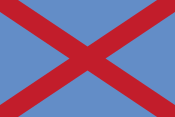| Army Comrades Association | |
|---|---|
 | |
| Also known as | Blueshirts |
| Leader | Ned Cronin[1] Eoin O'Duffy[2] Thomas F. O'Higgins Ernest Blythe |
| Foundation | 9 February 1932 |
| Dissolved | 1935 |
| Merged into | Fine Gael (pro-Cronin faction) |
| Country | |
| Newspaper | The Nation |
| Ideology | Anti-communism Irish nationalism Integral nationalism Corporate statism[3] National Catholicism[4] |
| Political position | Far-right[5] |
| Size | 8,337 (October 1932) 38,000 (March 1934) 48,000 (peak; August 1934) 4,000 (September 1935)[6] |
| Flag |  |
The Army Comrades Association (ACA), later the National Guard, then Young Ireland[a] and finally League of Youth, but best known by the nickname the Blueshirts (Irish: Na Léinte Gorma), was a paramilitary organisation in the Irish Free State, founded as the Army Comrades Association in Dublin on 9 February 1932.[7] The group provided physical protection for political groups such as Cumann na nGaedheal from intimidation and attacks by the IRA.[8] Some former members went on to fight for the Nationalists in the Spanish Civil War after the group had been dissolved.
Most of the political parties whose meetings the Blueshirts protected would merge to become Fine Gael, and members of that party are still sometimes nicknamed "Blueshirts".[9] There has been considerable debate in Irish historiography over whether or not it is accurate to describe the Blueshirts as fascists.[9]
- ^ Cronin, M.; Regan, J. (2000). Ireland: The Politics of Independence, 1922-49. Palgrave Macmillan UK. p. 65. ISBN 9780230535695.
- ^ McGarry, Fearghal (2005). Eoin O'Duffy: A Self-Made Hero. OUP Oxford. p. 209. ISBN 0199276552.
- ^
Badie, Bertrand; Berg-Schlosser, Dirk; Morlino, Leonardo, eds. (7 September 2011). International Encyclopedia of Political Science. SAGE Publications (published 2011). ISBN 9781483305394. Retrieved 9 September 2020.
[...] fascist Italy [...] developed a state structure known as the corporate state with the ruling party acting as a mediator between 'corporations' making up the body of the nation. Similar designs were quite popular elsewhere in the 1930s. The most prominent examples were Estado Novo in Portugal (1932-1968) and Brazil (1937-1945), the Austrian Standestaat (1933-1938), and authoritarian experiments in Estonia, Romania, and some other countries of East and East-Central Europe,
- ^ Stanley G. Payne (1984). Spanish Catholicism: An Historical Overview. Univ of Wisconsin Press. p. xiii. ISBN 978-0-299-09804-9.
- ^ O'Connor, Eimear (2009). Sean Keating in Context: Responses to Culture and Politics in Post-civil War Ireland. Carysfort Press. p. 36. ISBN 978-1904505419.
- ^ Cite error: The named reference
Membershipwas invoked but never defined (see the help page). - ^ New Irish Army Arises, New York Times, August 12, 1932
- ^ R. M. Douglas, "Architects of the Resurrection: Ailtirí na hAiséirghe and the Fascist 'New Order' in Ireland, Manchester University Press, ISBN 0-7190-7998-5
- ^ a b Cite error: The named reference
Without the Blueshirtswas invoked but never defined (see the help page).
Cite error: There are <ref group=lower-alpha> tags or {{efn}} templates on this page, but the references will not show without a {{reflist|group=lower-alpha}} template or {{notelist}} template (see the help page).